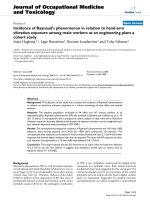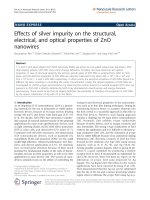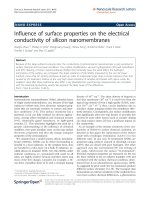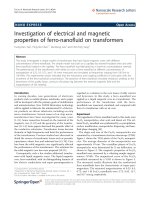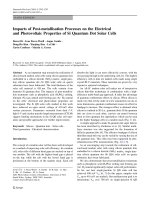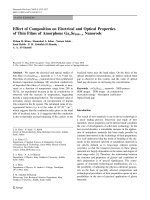Báo cáo hóa học: " Department of Electrical Engineering, University of " doc
Bạn đang xem bản rút gọn của tài liệu. Xem và tải ngay bản đầy đủ của tài liệu tại đây (578.1 KB, 2 trang )
EURASIP Journal on Applied Signal Processing 2003:4, 319–320
c
2003 Hindawi Publishing Corporation
Editorial
Kung Ya o
Department of Electrical Engineering, University of California, Los Angeles (UCLA), Los Angeles, CA 90095-1594, USA
Email:
Deborah Estrin
Department of Computer Science, University of California, Los Angeles (UCLA), Los Angeles, CA 90095-1596, USA
Email: destrin@c s.ucla.edu
Yu Hen Hu
Department of Electrical and Computer Engineering, University of Wisconsin-Madison, 1415 Engineering Drive,
Madison, WI 53706-1691, USA
Email:
Advances in low-cost and low-power wireless communica-
tion, microsensor, and microprocessor hardware, as well as
progress in ad hoc networking routing and protocols, dis-
tributed signal and array processing, pervasive computing,
and embedded systems have all made sensor networking a
topic of active interest. In recent years, the Internet has been
able to provide a large number of users with the ability to
move diverse forms of information readily and thus rev-
olutionized business, industry, defense, science, education,
research, and human interactions. Sensor networking may,
in the long run, be equally significant by providing mea-
surement of the physical phenomena around us, leading to
their understanding and ultimately the utilization of this in-
formation for a wide range of applications. Potential appli-
cations of sensor networking include environmental moni-
toring, health care monitoring, battlefield surveillance and
reconnaissance, modern highway, modern manufacturing,
condition-based maintenance of complex systems, and so
forth.
In order to understand and build sensor networks, di-
verse technology and technical disciplines are involved. How-
ever, in this special issue we deal only with various signal pro-
cessing aspects of sensor networking. Of the seven papers,
four of them deal with source localization, two of them with
tracking, and one with sensor network decomposition and
organization. Energy-Based Collaborative Source Localization
Using Acoustic Microsensor Array, by D. Li and Y. H. Hu, uses
acoustic energy measurements to perform source localiza-
tion. This approach assumes the acoustic source energy de-
cays inversely with the square of the distance. By compar-
ing acoustic sensor energy measurements around the source,
the source location can be estimated as the intersection of
multiple hyperspheres. The Fusion of Distributed Microphone
Arrays for Sound Localization, by P. Aarabi, also deals with
acoustic source localization. The author proposes to use the
spatial observability function (SOF), which gives an indica-
tion of how well a microphone array perceives events at dif-
ferent spatial position. Each microphone array also has a spa-
tial likelihood function (SLF) which reports the likelihood of
a source at each spatial location. SOF and SLF approaches are
used together for sound localization. In A Self-Localization
Method for Wireless Sensor Networks,byR.L.Moses,D.
Krishnamurthy, and R. Patterson, the authors consider the
problem of locating and orienting a network of unattended
sensors by using a number of known source signals for cal-
ibration purposes. The maximum-likelihood (ML) estima-
tion and Cram
´
er-Rao Bound (CRB) techniques are used.
Acoustic Source Localization and Beamforming: Theory and
Practice, by J. C. Chen, K. Yao, and R. E. Hudson, again uses
the ML method for direct localization of wideband acousti-
cal source in the near field and uses the cross bearing of the
direction-of-arrivals (DOA) for localization in the far field.
For multiple sources, an alternating projection procedure is
used. CRB analysis provides various insights for the local-
ization problem. Dynamic Agent Classification and Tracking
Using an Ad Hoc Mobile Acoustic Sensor Network,byD.Fried-
lander, C. Griffin, N. Jacobson, S. Phoha, and R. R. Brooks,
presents methods for dynamic distributed signal processing
using an ad hoc mobile network of sensors to detect, identify,
and track targets. Forming dynamic clusters around events
of interest allows for processing multiple events in parallel
over different geographic areas along the trajectory of the tar-
gets. In Collaborative In-Network Processing for Target Track-
ing, J. Liu, J. Reich, and F. Zhao consider collaborative signal
320 EURASIP Journal on Applied Signal Processing
processing using acoustic-amplitude sensors for target dis-
tance estimation and DOA sensors for bearing estimation.
The information-driven sensor querying framework selec-
tively activates sensors based on their utility and cost. Is-
sues of distributed processing for tracking and energy effi-
ciency of the network are addressed. Preprocessing in a Tiered
Sensor Network for Habitat Monitoring,byH.Wang,D.Es-
trin, and L. Girod, considers some common principles for
task-decomposition and collaboration for tiered sensor net-
works. The system has a few powerful macronodes in the
first tier and many less-powerful nodes in the second tier.
Each macronode combines data collected by many micron-
odes for target classification and localization. Application is
made to habitat monitoring and classification and localiza-
tion of birds. All seven of these papers use simulations and
measured data to verify the proposed methods. In the com-
ing years, it is expected that sensor networking will become
ever more important both in research and industry and that
hardware and software availability will enable significant data
collection and field experimentation.
Kung Yao received the B.S.E. (Highest Hon-
ors), M.A., and Ph.D. degrees in electrical
engineering all from Princeton University,
Princeton, NJ. He was a NAS-NRC Postdoc-
toral Research Fellow at the University of
California, Berkeley. Presently, he is a Pro-
fessor in the Electrical Engineering Depart-
ment at UCLA. In 1969, he was a Visit-
ing Assistant Professor at the Massachusetts
Institute of Technology. In 1985–1988, he
served as an Assistant Dean of the School of Engineer ing and Ap-
plied Science at UCLA. His research and professional interests in-
clude sensor array system, digital communication theory and sys-
tem, smart antenna and wireless radio system, chaos communica-
tions and system theory, digital and array and signal and array pro-
cessing, systolic and VLSI algorithms, architectures and systems,
radar system, and simulation. He has published over 250 journal
and conference papers. Dr. Yao received the IEEE Signal Processing
Society’s 1993 Senior Award in VLSI Signal Processing. He was the
coeditor of a two-volume series of an IEEE Reprint Book on High
Performance VLSI Signal Processing, IEEE Press, 1997. In 1991–
1993, he was the Associate Editor of VLSI Signal Processing of the
IEEE Trans. on Circuits and Systems. Since 1999, he is an Associate
Editor of the IEEE Communications Letters. He is a member of the
Editorial Board of the Journal of VLSI Signal Processing and Inte-
gration: the VLSI Journal. He was also a Guest Editor of a Special
Issue on Applications of Chaos in Modern Communication Systems
of the IEEE Trans. on Circuits and Systems—Part I in 2001. He is a
Fellow of IEEE.
Deborah Estrin is a Professor of computer
science at UCLA and Director of the Center
for Embedded Networked Sensing (CENS),
a newly awarded National Science Founda-
tion Science and Technology Center. She re-
ceived her Ph.D. degree in computer science
from the MIT (1985) and was on the fac-
ulty of Computer Science at USC from 1986
through mid-2000, where she received the
National Science Foundation, Presidential
Young Investigator Award for her research in network interconnec-
tion and security (1987). D uring the subsequent 10 years her re-
search focused on the design of network and routing protocols for
very large, global networks. Estrin has been instrumental in defin-
ing the national research agenda for wireless sensor networks, first
chairing a 1998 DARPA ISAT study and then a 2001 NRC study; the
latter culminated in an NRC publication—Embedded Everywhere:
A Research Agenda for Networked System of Embedded Computers.
Estrin’s research group develops algorithms and systems to sup-
port rapidly-deployable and robustly operating networks of many
thousands of physically embedded devices. She is particularly in-
terested in applications to environmental monitoring. Estrin has
served on numerous program committees and editorial b oards,
including SIGCOMM, Mobicom, SOSP, and ACM/IEEE Transac-
tions on Networks. She is a Fellow of the ACM and the AAAS.
Yu Hen Hu received the B.S.E.E. deg ree
from National Taiwan University, Taiwan,
in 1976. He received the M.S. and Ph.D.
degrees both in electrical engineering from
University of Southern California, Los An-
geles, Calif in 1980 and 1982, respectively.
Currently, he is a Professor at the Electrical
and Computer Engineering Department of
the University of Wisconsin-Madison, Wis,
USA. Previously, he has been with the Elec-
trical Engineering Department of the Southern Methodist Univer-
sity, Dallas, Tex, USA. Dr. Hu’s research interests include multime-
dia signal processing, design methodology and implementation of
signal processing algorithms and systems, sensor network and dis-
tributive signal processing algorithms, and neural network signal
processing. He published more than 200 journal and conference
papers and edited two books: Programmable Digital Signal Proces-
sors and Handbook of Neural Network Signal Processing.Dr.Huis
a Fellow of IEEE. He served as Associate Editor for IEEE Trans-
actions on Signal Processing, IEEE Signal Processing Letters, Jour-
nal of VLSI Signal Processing, EURASIP Journal on Applied Signal
Processing. He served as Secretary of IEEE signal processing soci-
ety, board of governors of IEEE neural network council, Chair of
IEEE signal processing society, and neural network signal process-
ing technical committee.
